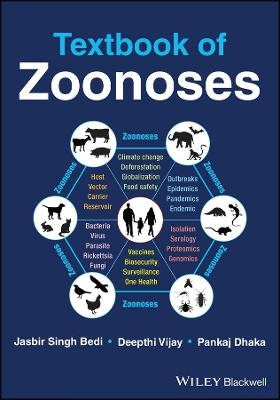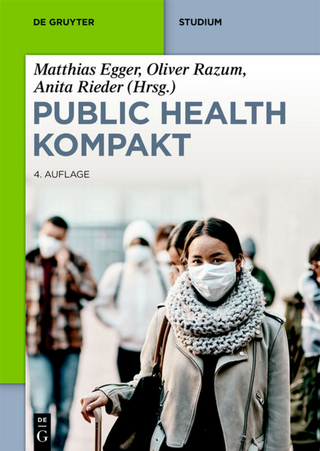
Zoonoses are the diseases which can spread from animals to humans. This book covers all important zoonoses that are prevalent in today's world. As a modern learning resource, it incorporates recent scientific developments and concepts to give readers a complete overview of each zoonoses. Written by three well-qualified authors in academia, sample topics covered within the book include:
- Bacterial, viral, parasitic, rickettsial, fungal, prion, and foodborne zoonoses
- Aetiology and epidemiology of each zoonotic disease
- Clinical symptoms and diagnosis in animals and humans
- Treatment options, plus prevention and control strategies
- CDC classification of zoonotic agents and the WHO's list of 'neglected zoonoses'
Written for undergraduate and postgraduate students studying veterinary public health and epidemiology, Textbook of Zoonoses is also a helpful resource for other veterinary and medical professionals interested in public health and epidemiology.
Dr Jasbir Singh Bedi, Professor, Centre for One Health, College of Veterinary Science, Guru Angad Dev Veterinary and Animal Sciences University, Punjab, India.
Dr Deepthi Vijay, Assistant Professor, College of Veterinary and Animal Sciences, Kerala Veterinary and Animal Sciences University, Kerala, India.
Dr Pankaj Dhaka, Assistant Professor, Centre for One Health, College of Veterinary Science, Guru Angad Dev Veterinary and Animal Sciences University, Punjab, India.
Foreword
Preface
Acknowledgements
Introduction to Zoonoses
Understanding concepts and terms related to Zoonoses
SECTION 1: BACTERIAL ZOONOSES
1. Anthrax
2. Brucellosis
3. Cat-scratch disease
4. Glanders
5. Leptospirosis
6. Lyme disease (or Lyme borreliosis)
7. Plague
8. Q fever
9. Tularemia
10. Zoonotic Chlamydiosis
11. Zoonotic Tuberculosis
12. Other zoonoses
a. Meliodiosis
b. Tetanus
c. Dog-bite transmitted bacterial pathogens
d. Rat Bite Fever agents
Bacterial foodborne pathogens
(Bacillus cereus, Campylobacteriosis, Clostridium perfringens, Clostridium botulinum, Diarrhoeagenic Escherichia coli, Listeria monocytogenes, Salmonellosis, Staphylococcus aureus, Vibriosis and Yersiniosis)
SECTION 2: VIRAL ZOONOSES
Introduction
13. Crimean Congo Haemorrhagic Fever (CCHF)
14. Ebola Haemorrhagic Fever
15. Hantavirus disease
16. Influenza viruses
17. Japanese Encephalitis
18. Nipah
19. Rabies
20. Rift Valley Fever
21. West Nile Fever
22. Yellow Fever
23. Zoonotic Coronaviruses
24. Viral Haemorrhagic fevers (Arenaviruses, Bunyaviruses, Filoviruses and Flaviviruses)
25. Other Zoonotic Viruses of Public Health Importance
(Eastern equine encephalomyelitis (EEE), Western equine encephalomyelitis (WEE), Venezuelan equine encephalomyelitis (VEE), Foot and mouth disease (FMD), Hendra virus (HeV), Herpes B Virus (Cercopithecine herpesvirus 1), La Crosse encephalitis virus (LACV), Lymphocytic choriomeningitis virus (LCMV), Monkeypox virus, Powassan virus (POWV), Saint Louis encephalitis virus (SLEV)
26. Foodborne viral zoonoses
SECTION 3: PARASITIC ZOONOSES
Introduction
27. Amoebiasis
28. Balantidiasis
29. Cryptosporidiosis
30. Cutaneous Larvae Migrans
31. Diphyllobothriasis
32. Echinococcosis
33. Giardiasis
34. Leishmaniasis
35. Sarcocystosis
36. Schistosomiasis
37. Taeniasis/Cystecercosis complex
38. Toxoplasmosis
39. Trichinellosis
40. Trypanosomiasis
41. Visceral Larvae Migrans
42. Other parasitic zoonoses of public health importance
a. Angiostrongyliasis
b. Anisakiasis
c. Clonorchiasis
d. Dracunculiasis
e. Fasciolopsiasis
f. Paragonimiasis
g. Pentastomiasis
h. Primary Amoebic Meningoencephalitis (PAM)
SECTION 4: FUNGAL ZOONOSES
Introduction
43. Aspergillosis
44. Blastomycosis
45. Coccidioidomycosis
46. Cryptococcosis
47. Dermatophytosis
48. Histoplasmosis
49. Mucormycoses
50. Sporotrichosis
51. Other important fungal zooonoses
SECTION 5: RICKETTSIAL ZOONOSES
Introduction
A. Typhus group
1. Epidemic typhus
2. Endemic typhus
B. Spotted fever group
1. Tick borne spotted fever
a. Rocky Mountain spotted fever
b. Other important tick-borne spotted fever rickettsioses
2. Flea-borne spotted fever
3. Mite-borne spotted fever
C. Scrub typhus
Diagnosis of rickettsioses
SECTION 6: PRION DISEASES
ANNEXURES
1. Important Global Health Days
2. List of important zoonoses related to farm animals and pets
3. CDC classification of bioterrorism agents
References
Credits and Sources/Acknowledgments
Index
| Erscheinungsdatum | 15.07.2022 |
|---|---|
| Verlagsort | Hoboken |
| Sprache | englisch |
| Maße | 178 x 254 mm |
| Gewicht | 860 g |
| Einbandart | kartoniert |
| Themenwelt | Medizin / Pharmazie ► Medizinische Fachgebiete ► Mikrobiologie / Infektologie / Reisemedizin |
| Studium ► Querschnittsbereiche ► Epidemiologie / Med. Biometrie | |
| Studium ► Querschnittsbereiche ► Prävention / Gesundheitsförderung | |
| Veterinärmedizin ► Klinische Fächer ► Mikrobiologie / Immunologie | |
| Schlagworte | Zoonosen |
| ISBN-10 | 1-119-80951-7 / 1119809517 |
| ISBN-13 | 978-1-119-80951-7 / 9781119809517 |
| Zustand | Neuware |
| Informationen gemäß Produktsicherheitsverordnung (GPSR) | |
| Haben Sie eine Frage zum Produkt? |
aus dem Bereich


